Controlling White Grubs in Turfgrass
ENT-10: Controlling White Grubs in Turfgrass | Download PDF
by Daniel A. Potter and Michael F. Potter, Entomologists
University of Kentucky College of Agriculture
White grubs are the most destructive insect pests of turfgrasses in Kentucky. Turf is damaged when the grubs (the larval or immature stages of certain beetles) chew off the grass roots just below the soil surface. The root injury reduces the turf's ability to take up water and nutrients and withstand the stress of hot, dry weather conditions.
Several species of white grubs can cause this damage, but the two that are most common in Kentucky are the larvae of masked chafers and Japanese beetles. Other species occasionally infesting turfgrass in Kentucky are the larvae of green June beetles, May beetles, and the black turfgrass ataenius.
All of these grubs have stout, grayish-to-white bodies with brown heads. Depending upon the species, the mature grub ranges in size from 3/8 to 2 inches long. Most species are curled into a C-shape when at rest (Figure 1), although green June beetle grubs have the curious habit of crawling on their backs.
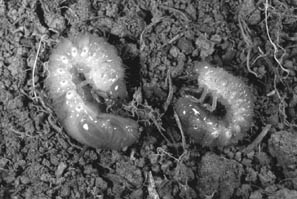
Figure 1. Mature white grubs (photo: M.L. Johnson)
Signs of Infestation
White grub damage is usually most evident in August and September. Early symptoms include gradual thinning, yellowing, and weakening of the grass stand followed by the appearance of scattered, irregular dead patches. As damage continues, the dead patches may increase in size, and apparently healthy turf areas may exhibit sudden wilting. The turf may feel spongy as you walk over the infested area.
Sod that is heavily grub-damaged is not well anchored, and you can pull it loose from the soil as if lifting a carpet. If the brown patches do not pull up easily, the problem is usually related to other causes, e.g., a localized dry spot, dog urine damage, fertilizer burn, subsurface rocks, or disease. If the turf does pull up easily, inspect the top 1 to 2 inches of soil for the white, C-shaped larvae. Sampling of potential infestation sites and early recognition of a grub problem can prevent turf loss and costly renovation.
If your turf had a serious grub problem last year, the adult beetles are likely to return and reinfest the same areas. Sites with a large number of adult beetles in June and July are more likely to have grubs in late summer. Early warning signs include swarms of brown, 1/2-inch long masked chafer beetles skimming over the turf at dusk, or green June beetles buzz-bombing the turf by day in search of mates and egg-laying sites. Masked chafer and May beetle adults also are attracted to porch and street lights at night. Adult Japanese beetles are daytime fliers that feed on the leaves, flowers, and fruit of various plants. Heavy infestation of adult Japanese beetles feeding in the area could foretell subsequent white grub problems.
Another indication that white grubs may be present is moles, skunks, raccoons, or flocks of blackbirds finding the turf attractive. However, these predatory varmints may be interested in earthworms or other soil insects in addition to grubs. Large numbers of dark-colored, parasitic wasps hovering over the lawn in late summer to early fall may also be a sign of white grubs, especially green June beetle grubs. Sample the lawn to confirm that a white grub problem truly exists.
Sampling for White Grubs
To determine the extent of infestation, sample the turf in several spots. In each area, cut out a square-foot piece of sod and inspect the roots and soil closely for grubs to about 2 inches (Figure 2). On golf courses, a standard cup cutter works well; multiply the number of grubs per cup core by 10 to get the average density per square foot.
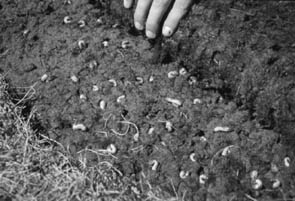
Figure 2. Sampling for white grubs.
If sampling is done during the early stages of infestation (mid-July to mid-August), the grubs will be small and not as easily found as when they have noticeably damaged the turf. After examining the sample, tamp it back into place and water it well to encourage regrowth. It is normal to find a few white grubs per square foot in lawns. The mere presence of grubs is not necessarily a cause for concern, because healthy turf can easily outgrow the root loss caused by a small number of white grubs. An average of eight or more grubs per sample may indicate a need for treatment, particularly when the lawn is under heat and drought stress. When the weather is cooler and soil moisture adequate, turf can tolerate higher grub densities without being damaged.
If you can identify correctly the type of white grub causing the problem, it will help with subsequent monitoring and in making control decisions. Masked chafer grubs have a chestnut-colored (reddish-brown) head, and Japanese beetle grubs have a tan-colored (yellowish-brown) head. Grubs found in Kentucky can also be identified by examining the rasters, the arrangement of small spines on the underside of the last body segment (Figure 3). A 10X hand lens is adequate for seeing these diagnostic features.
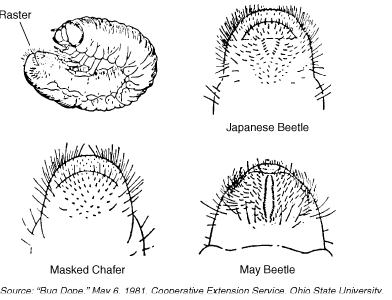
Figure 3. Raster patterns of some important grubworms.
The adult stages of lawn-infesting white grubs are easily distinguished from one another (Figure 4). Japanese beetles are 3/8 to 7/16 inch long and metallic green with coppery brown wing covers. A row of white tufts (spots) of hair project from under the wing covers on each side of the body. May beetles are solid brown and 3/4 to 1 inch long. Masked chafers are similar in shape but are only about 1/2 inch long. Green June beetles are 3/4 to 1 inch long and are emerald green except for a tan border on the sides of their wing covers.
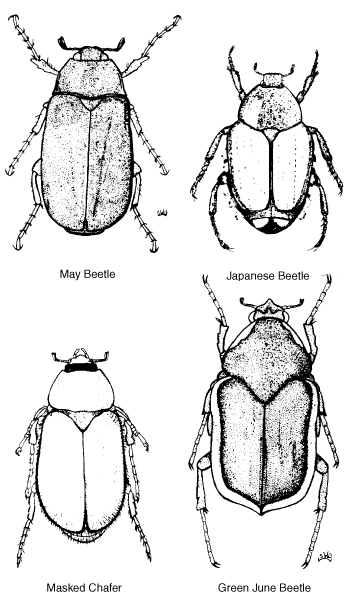
Figure 4. Adult stages of common white grub species.
Grub Life Cycles
Masked chafers, Japanese beetles, and green June beetles—the species most likely to damage turfgrass in Kentucky—have similar life cycles that take one year to complete. Adult beetles emerge, mate, and lay eggs in midsummer, mainly from late June until early August. Eggs are laid a few inches below the surface and hatch in about two weeks. The tiny (1/8 inch long) first-instar grubs (those just emerged from the egg) grow quickly, feeding on fine roots and organic matter. As they grow, the grubs molt (shed their skin) twice, the two post-molt stages being sequentially referred to as second and third instars. Most of the grubs are third instars by late summer or early fall.
In October or November, when soil temperatures begin to cool, the grubs cease feeding and move deeper into the soil, where they spend the winter. They return to the root zone and resume feeding early the following spring. When mature (typically in late May), the grubs again move deeper, form an earthen cell, and transform into pupae. The adult beetles emerge a few weeks later, in June and July, to complete the one-year cycle (Figure 5).
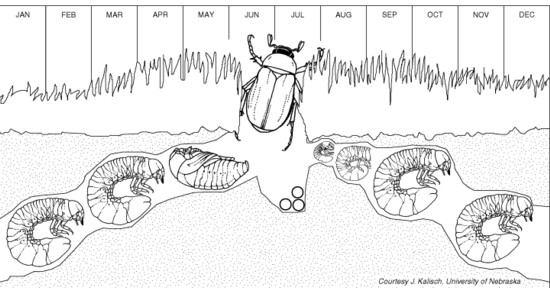
Figure 5. One-year life cycle of the masked chafer, a typical white grub.
Damage from grubs with annual life cycles usually appears in late August and September, when the third instars are vigorously feeding and the turf is otherwise stressed. Symptoms are usually less apparent during the spring feeding period. White grubs prefer grasses but may also feed on the roots of other plants, including weeds. Green June beetle grubs feed mainly on organic matter in the soil but damage turfgrasses by tunneling and pushing up small mounds of soil.
May beetles take two to three years to complete their cycle. These grubs may be abundant in pastures, but in Kentucky they are not often a problem in managed turf. Another species, the black turfgrass ataenius, has two generations per year. The adults are active in the spring (late March to early May) and again in midsummer. The grubs are present mainly from May to June and from August to September. Black turfgrass ataenius beetles are a sporadic problem on golf courses but rarely damage home lawns.
Management and Control Practices
Cultural Control
Consider renovating heavily grub-damaged Kentucky bluegrass or perennial ryegrass lawns with tall fescue, which is generally more tolerant of grubs than Kentucky bluegrass or perennial ryegrass. In Kentucky’s climate, tall fescue also has superior drought resistance, shade tolerance, traffic tolerance, and disease resistance. (For further information, see Kentucky Cooperative Extension Service publication AGR-51, Improving Turf Through Renovation.) Some tall fescue and perennial ryegrass cultivars contain endophytes, symbiotic fungi that provide resistance to certain insect pests such as sod webworms. Endophytes do not, however, provide significant resistance to white grubs.
Rainfall and soil moisture are critical factors that determine the extent of grub damage during a season. Frequent irrigation in June and July may attract egg-laying female beetles to the turf, especially if surrounding areas are dry. High soil moisture also increases egg survival. If lawns are irrigated during June and July, be especially alert for signs of grubs later in the summer. In contrast, adequate soil moisture in August and September (when grubs are actively feeding) can help hide root injury. Irrigated turf can sometimes tolerate 20 or more grubs per square foot before showing signs of injury. If grub damage starts to appear in late August or September, watering will promote tolerance and recovery. Thorough, periodic soaking of the turf is more beneficial than frequent, light watering.
Moderate nitrogen fertilization from October through December, which builds a strong root system, can further help turf resist grub injury. Heavy fertilization in the spring and summer increases turf stress and may accentuate white grub damage later in the fall.
Natural Enemies
In some areas, natural controls such as predators, parasites, and diseases can help keep white grubs in check. Predators such as skunks and moles, however, are as unwelcome as the grubs themselves because they damage lawns while digging for food. Contrary to popular belief, killing grubs in the turf does not eliminate mole activity, because these animals also feed on earthworms and other types of soil insects. Controlling grubs may, however, discourage digging by skunks and raccoons.
Certain species of wasps parasitize white grubs. The most obvious ones are black and hairy and often have yellow or brightly colored markings (Figure 6). These wasps are sometimes seen hovering over the turf in late summer in search of green June beetle grubs on which to lay their eggs. They are not aggressive and normally will not sting people. The wasp larva feeds externally upon the grub, eventually killing its victim before spinning a fuzzy, brown, jelly bean-size cocoon in the soil. Other, less conspicuous species of wasps parasitize masked chafer and Japanese beetle grubs. Although the wasps seldom give the degree or reliability of control desired, they provide some natural suppression, so it is wise to conserve them. Predators such as ground beetles and ants also take their toll on eggs and young white grubs. None of these naturally occurring agents are commercially available for purchase and release by turf managers.
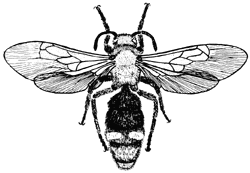
Figure 6. Scolia sp.—a white grub parasite.
Milky disease spore dusts (commercial preparations of the bacterium Paenibacillus popilliae) have been marketed for use against Japanese beetle grubs for many years, but these products have not been effective in University of Kentucky research trials. Other grub species (e.g., masked chafers, May beetles, June beetles) are unaffected by the strain of bacteria contained in the products, which further reduces their usefulness.
Commercial insect-parasitic nematodes are also available for white grub control. Nematodes work better under moist soil conditions than in dry soils. If targeting white grubs, use a product containing the nematode Heterorhabditis bacteriophora (not Steinernema carpocapsae, which is better suited for controlling turf caterpillars). Be sure to follow directions on the label about pre- and post-treatment watering and application during cool periods of the day. In Kentucky, performance of nematodes has been less consistent than that of conventional insecticides.
Insecticide Treatment
When white grubs are abundant, applying a soil insecticide may be the only way to avoid serious damage to the turf. Two different strategies are available for controlling grubs with insecticides: curative and preventive. Each approach has its own merits and limitations. Regardless of the product, post-treatment irrigation should be applied to water the insecticide residues into the root zone (see below).
The Curative Approach
With curative control, treatment is applied in late summer, after the eggs have hatched and grubs are present. Insecticides used for curative control have relatively short residual effectiveness (usually 2 to 3 weeks or less). Therefore, proper timing is important. The best time to apply curative grub insecticides in Kentucky is in early to mid August when grubs are still small and their feeding damage is relatively light. Grubs are still vulnerable to treatment in late August and September but as they grow larger, they become progressively harder to control, and damage to the turf already may be severe. By late September, in response to cooler soil temperatures, some grubs already may be moving downward and out of the treatment zone. Remember to water-in the insecticide as soon as possible after the application.
Spring generally is not a good time for curative grub control. Grubs that have overwintered are large and hard to kill, and because weather conditions are moderate, the turf will usually outgrow whatever damage the grubs may do before transforming to pupae. Also, using a curative insecticide with a limited residual effect in April or May affords no protection against re-infestation by egg-laying adult beetles later in the season. About the only time when spring treatment with curative insecticides might be justified is when reseeding grub-damaged areas where the grubs were not controlled the previous fall.
Curative treatments are an effective control strategy when damaging grub populations are known to be present. Ideally, the decision to treat is based on site inspection and sampling or on past infestation history. Since white grub infestations tend to be localized, often only a part of the lawn will need to be treated. Grub “hot spots,” which can be confirmed by sampling, are most likely to be full sun, south- or west-facing slopes, lawns seeded with Kentucky bluegrass, lawns that were heavily irrigated during June and July, and turf areas damaged by grubs in previous years.
Proper timing of curative grub treatments can be tricky, however. Insecticides applied too early may degrade before the eggs have hatched, but if the product is applied too late, the grubs will be harder to kill and severe turf damage may have occurred already. In order to avoid these challenges, many turf managers are turning to a preventive strategy made possible by newer, longer-lasting insecticides.
The Preventive Approach
With preventive control, the insecticide is applied as insurance before a potential grub problem develops. Preventive treatments afford greater flexibility in application timing and are easier to schedule and implement than curative treatments. They also tend to be less dependent upon sampling and monitoring of grub populations. Preventive treatment often affords greater peace of mind to golf superintendents and some lawn service companies because potential damage is avoided or minimized. Preventive control requires the use of insecticides with long residual activity in soil. Several such products are available and give excellent control of newly hatched white grubs when applied weeks—or even 2 to 3 months—before the grubs have hatched. These modern soil insecticides have selective activity on target insects and pose relatively little hazard to humans, pets, birds, fish, or the environment.
Turf managers who use the preventive approach must use a different timing than they would for curative or “rescue” treatments. Preventive grub insecticides are highly effective against young, newly hatched grubs. Applications made as early as May usually have sufficient soil residual to control young grubs hatching from eggs in July or early August. In general, however, the optimum period for applying preventive grub treatment is mid-June to mid-July, during the month or so preceding egg hatch until the time when very young grubs are present. Preventive grub insecticides are substantially less active against older, full-sized (third-instar) grubs so they are not well-suited for curative treatment in late summer, or after grub damage is apparent. As with curative treatments, water-in the insecticide after application.
The main drawback of preventive grub control is that the decision to treat must be made before knowing the extent of infestation. Grub outbreaks tend to be localized and sporadic and only a small percentage of lawns require treatment in a given year. Thus, preventive control often results in areas being treated unnecessarily. Good record keeping and observation will help you pinpoint grub-prone areas, which are the most logical location for preventive applications.
For a current list of insecticides available for curative and preventive grub control in turf, see Kentucky Cooperative Extension Service ENTFact-441, Insecticides for Control of White Grubs in Kentucky Turfgrass.
Optimizing Effectiveness of Grub Treatments
Grub treatments must be applied at the appropriate time of year—August or early September for curative products, or mid-May through July for preventive treatments. If you don’t adhere to these recommended “treatment windows,” poor control often results.
For best results with any grub insecticide, mow the lawn and rake out dead grass and thatch before treatment, which allows the spray or granules to penetrate better and reduces the amount of insecticide bound up by surface debris. White grubs are especially hard to control in thatch-filled turf because most of the insecticide becomes tied up in the organic matter and fails to reach the root zone. If the thatch layer is more than 1/2 inch thick, consider removing it with a dethatching machine before applying a grub treatment (see Cooperative Extension Publication AGR-54, Mowing, Dethatching, Coring, and Rolling Kentucky Lawns).
Water the lawn immediately after treatment to leach the insecticide into the root zone where the grubs are feeding. Another reason to irrigate is that moisture draws grubs closer to the soil surface, increasing their contact with the insecticide residues. Use a lawn sprinkler to drench the soil with 1/2 to 1 inch of water, which can be measured by placing a disposable pan or rain gauge in the treated area. If supplemental irrigation is not available, try to apply the insecticide just before a good rain. Prompt, post-treatment irrigation is especially important for spray applications; once spray residue dries on foliage it is more difficult to wash it into the root zone by later watering. Granular insecticide formulations may work better when you can’t irrigate right away. Preventive grub insecticides, with their relatively long residual effectiveness, tend to be more forgiving than the curative products if post-treatment watering is unavoidably delayed for a few days.
Responsible Pesticide Use
When used correctly, modern turf insecticides pose relatively little hazard and can help prevent serious grub damage. However, the following appropriate precautions must be followed to minimize potential risks to people, pets, and the environment:
- Read the entire pesticide label, and follow its instructions.
- Purchase only the amount of insecticide needed for the job. Grub control applications are based on the amount of product per 1,000 square feet of area to be treated. Measuring the area to be treated beforehand will help you determine how much product to buy.
- Never dispose of leftover pesticides in the toilet, drain, or sink. Doing so can cause serious problems at the sewage treatment plant and to the environment if they find their way into streams.
- Pesticides and rinsate (from cleaning out sprayers) should never be discarded or allowed to flow into storm drains, streams, or other bodies of water. The best way to dispose of leftover material is to apply it to the turf or other application site(s) listed on the label.
- Load, mix, empty, and rinse all pesticide application equipment on the lawn—not on the driveway or sidewalk—to lessen the risk of pesticide runoff into undesirable areas.
- During application, try to keep granules and overspray off pavement and other hard surfaces, which also helps prevent runoff into storm drains and other non-target areas. Excess granules on driveways or sidewalks should be swept back into the turf.
- Avoid applying pesticides in windy conditions, especially when using sprays which readily drift off target.
- Keep people and pets off treated areas until the pesticide has washed into the soil and the foliage has dried. Consult specific product labels for additional reentry requirements.
Revised: 4/07
CAUTION! Pesticide recommendations in this publication are registered for use in Kentucky, USA ONLY! The use of some products may not be legal in your state or country. Please check with your local county agent or regulatory official before using any pesticide mentioned in this publication.
Of course, ALWAYS READ AND FOLLOW LABEL DIRECTIONS FOR SAFE USE OF ANY PESTICIDE!
Images: University of Kentucky Entomology except raster patterns image: Ohio State University
